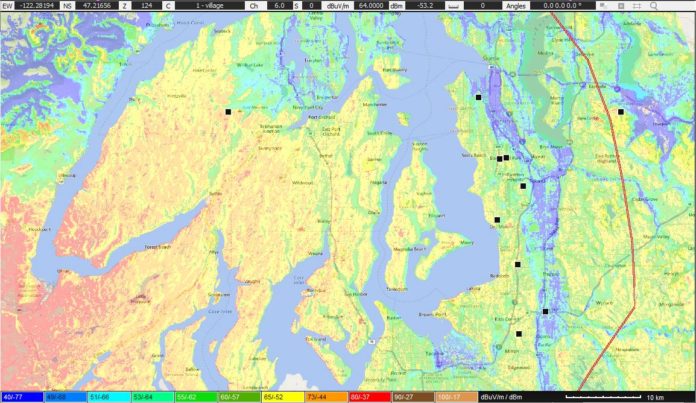There’s a Class C 64kw FM facility serving the Seattle-Tacoma region’s Hispanic audience by providing regional Mexican programming. It’s a big stick, hence its moniker: “La Gran D.”
But, this station is licensed to Elma, Washington and uses a tower well to the southwest of downtown Seattle. The result: Signal holes in the metropolitan area.
This issue has just been resolved in a big way, as the station is now the latest licensee of Maxxcasting technology.
The MaxxCasting system deployment at Bustos Media‘s KDDS-FM 99.3 went live in late June. “It has solved the station’s greatest coverage challenges associated with graphically shadowed terrain and poor building penetration,” MaxxCasting says.
The specific synchronized, single-frequency network (SFN) architecture includes five nodes strategically positioned alongside the interstate to maximize signal penetration, with seamless transitions from one transmitter to the next as drivers move through the region.
“Like several other Seattle FM stations that broadcast from across the Puget Sound, KDDS was challenged by a ridge that almost completely shadowed Interstate 5 and the heavily populated neighborhoods just to the east,” said Bill Hieatt, CTO of GeoBroadcast Solutions, the architects of MaxxCasting. “Listeners driving through the region are no longer changing stations due to interference and loss of signal, while businesses and residential neighborhoods that previously could not hear the station are receiving clean and consistent broadcasts.”
In addition to eliminating multipath interference that once existed for KDDS across 70% of the market, MaxxCasting has also improved the station’s ability to reach Nielsen PPM holders across the region.
The MaxxCasting solution utilizes proprietary watermarkingand monitoring to optimize PPM decoding.
“FM coverage in the Seattle region is extremely challenging, and MaxxCasting has made an enormous difference in the neighborhoods that are most important to our business, as well as other areas that are deeply shadowed,” said Amador Bustos, the longtime owner of radio stations targeting Spanish speakers. “We can also now visit businesses around the region and say, ‘listen to our station with confidence’ as we discuss potential advertising campaigns. We simply could not reach a majority of these businesses before. In addition to raising our profile with advertisers with this system, listeners around the region have been remarking about how much of a difference they are hearing.”
To date, MaxxCasting deployments have been seen in Boston, Chicago and Milwaukee; and in regions with more mountainous and hilly terrain such as West Virginia.
“When you’re 50 miles to the west and trying to broadcast over these ridges, a traditional configuration simply won’t be effective,” said Bert Goldman, the contract engineer in charge of the KDDS installation. “The RF runs very close to the earth’s surface at that distance, which makes the line of sight nearly underground. MaxxCasting provides a system architecture with flexible parameters to meet virtually any terrain challenge.”
The five SFN nodes in the KDDS MaxxCasting architecture are powered by GatesAir Flexiva FAX transmitters ranging from 99 Watts to 1 kW depending on local power needs. Each node incorporates patented Intraplex IP networking technology from GatesAir to simulcast and synchronize live program content, which ultimately contributes to a seamless transition from node to node as mobile audiences move through the market.
Unique antenna pattern designs control the extent of each node’s coverage, including one site with a dual log antenna positioned to maintain timing and delay in one challenging area of the network.
In addition to improving coverage-to-contour ratio, the MaxxCasting systems eliminate self-interference and signal degradation problems common with legacy booster systems. To outperform legacy systems, GBS uses modeling software, drive testing and proprietary formulas to measure a variety of environmental factors that affect coverage. Calculations related to height above average terrain, distance and power ratio between nodes, and antenna patterns versus interference areas, are among those used to predict coverage improvements. These customized settings at once improve market penetration and eliminate interference between the nodes.





